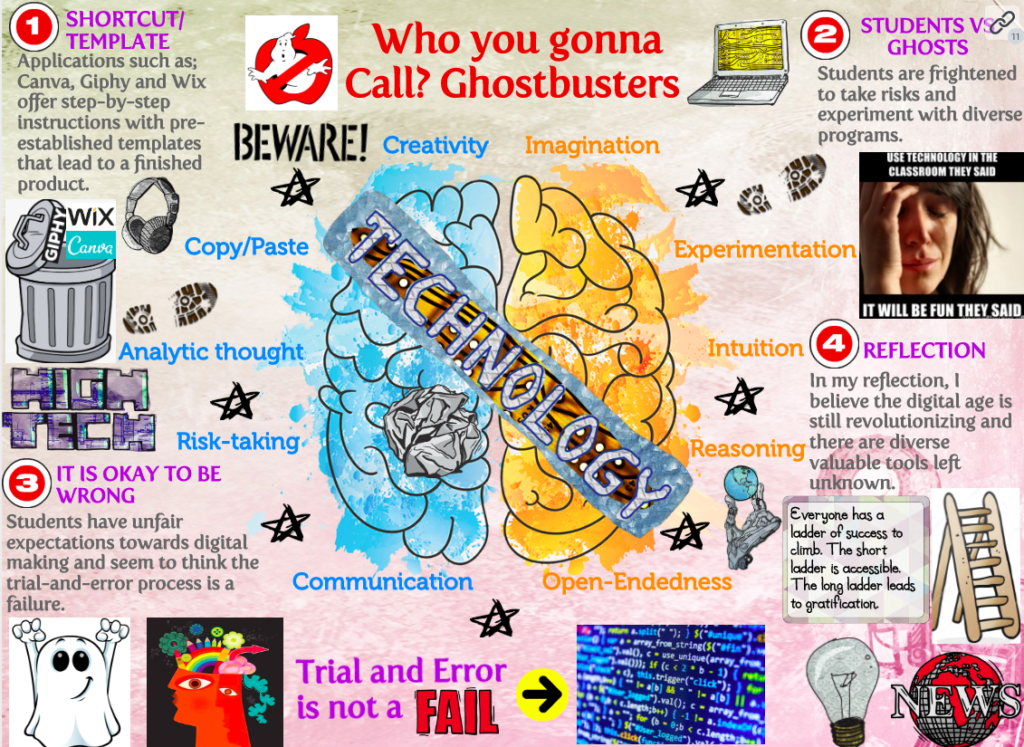http://hybridpedagogy.org/digital-ghosts-modern-classroom/

For this assignment, I decided to explore Hincks article called ‘‘Digital Ghosts in the Modern Classroom’’ to delineate the critical digital pedagogy. Hinks focuses on the linear way of learning that our school systems have ultimately developed. It was a very interesting topic to read because Hincks also incorporated and analyzed the different roles, effects, and applications that the media has on K-12 students. Throughout the article, there are diverse questions that got brought up discussing whether or not these shortcut/template websites are killing student’s creativity. I agree with the statement that school systems are killing student’s creativity due to the fact that teachers are promoting websites that are very user-friendly and offer pre-made templates with copy and paste features. In the past, I found these programs to be exceptional and convenient; however, I have concluded that students lack opportunities to express their creativity and imagination. Consequently, we are encouraging students to use shortcut/template-based applications in which their learning diminishes, and they do not gain any valuable skills. Are we praising students for following rigid instructions to achieve an overall expectation? Yes, yes we are.

This image is a human’s brain that is exploding with creativity. It is illustrated through the use of vibrant colours and sketches.
Personally, my classroom experiences have also included these shortcut template features. Every student was at a different level, and I found that by using these pre-designed templates, it justified that every student was forced to start with an identical base. Based on my teaching and learning comprehension thus far, my future students should be compelled to contribute their thoughts, and not be frightened to take risks while exploring a variety of softwares. I will allow my future students to have freedom in order to explore self-expression, creativity, and analytical thinking. I included keywords that circled the main image of the brain featured in my Glogster because I found these qualities to be very important when I was a student. Based on my experiences, not only will my students learn from me, but I will learn from them. The year I obtain my Bachelor of Education is not the year that I stop learning. With that being said, I will continuously strive to attend conferences, additional courses/qualifications and discuss with my colleagues.
Additionally, this technological barrier that co-exists amongst generations may be concerning the teacher’s inability to fully understand the technology and their willingness to experiment with the digital technological education process. Even if educators leave the templates and long-established worksheets behind, and apply technologies that encourage risk-taking, exploration and intuition, the expectations still linger in the classroom affecting student’s willingness to experiment with different learning approaches. Nonetheless, a good number of teachers are adapted to traditional school cultures designing one correct method to attain the ‘right answer’. With that being said, it generates students to feel frightened to take risks because they are afraid of the trial-and-error process. The trial-and-error processes are very important for students to gain valuable knowledge and application-based skills in the field because they will ultimately learn from their mistakes. I believe students do not experiment with different software’s because they are comfortable, and they expect instant gratification with an immediate payout; however, if we slowly begin to implement changes, we can convince students that results will be more rewarding and successful at the end. In educational settings, it is crucial to learn and get accustomed to using more complex and challenging softwares in order to fully achieve expectations.

This image says “Trial & Error” and contains a pencil with an eraser that is frequently being used. This is to encourage students to make mistakes and try again. Nobody is perfect!
To conclude, I do not suppose these changes will happen overnight. However, with time, knowledge, and experience, educators will properly begin to implement new technology into their classrooms. As we learned in our Digital Tech classroom, chairs are a technology that conceptualizes behaviour, and students are always the ones sitting in the chairs while the teacher is standing, so all the attention is directed towards him/her. However, teaching is not all about the classroom setup, relationships with students or lesson plans, it is about adding concrete technologies that are missing in classrooms. In the near future, I look forward to guiding my students in becoming exceptional creators and individual thinkers. This article has provided me a whole new perspective on digital media and inclusivity in classrooms, and I firmly believe we should distance ourselves from the shortcut/template and copy and paste features. By doing so, educational institutions will lean towards creative applications that will explore self-expression and invoke risk-taking skills.
Leave the shortcut/template websites behind!
The future generations are full of capable creators!

This image includes 7 students, and a teacher working together in a classroom with the help of digital literacy.
For this assignment, I decided to use Glogster! It was my first time experiencing with this website, as I wanted to challenge myself by using the free trial that was offered. It was fairly easy to use; however, when it came to converting the glog, it was not user-friendly in relation to files and formatting. With that being said, I could not demonstrate my Glogster’s interactive features on UWinDig. Nonetheless, this is a fantastic multimedia application to apply in my future classrooms, as it is beneficial for all types of learners. I could certainly use Glogster as a source in some of my lesson plans to enhance a certain topic with visual representations and engaging educational concepts! I think my students would enjoy experimenting with Glogster because it is very interactive, and contains diverse pertinent images/videos.

Jessica Beaulieu
